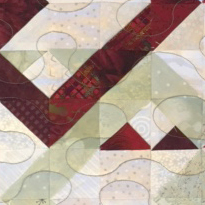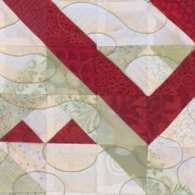|
Having been asked many times how these techniques came about, here is the history.... I learned to quilt in 1976, doing everything by hand. And for the next almost 30 years, that was the only way I worked. I never went to a show, class, quilt shop or guild meeting. I was a closet quilter - enjoying making my own patterns and working hard enough to make about one quilt per year. I did have a few magazines, but that was all (looked at the pictures, not the details). I only discovered the rotary cutter in 2004 so came late to the party. But, what a world of possibilities that opened up. I had been carrying around a sketch of a block for years (do not remember where it came from) and decided to make the quilt - which got to be quite large.
So, to use my spanking new rotary cutter and mat I considered how to approach this in the traditional manner which was to cut each piece individually, then sew them back together to make the units, take 16 units and make the block for a total of 35 individual pieces per block x 143 blocks. It just seemed an overwhelming prospect. Having made a few units and playing around with them I noticed a few things. 1. a few HSTS together, on the 45, made what looked like two strips. 2. a few QSTs together, on the 45, made what looked like a checker board and some strips. So, I started playing with the math to get the right strip widths to end up with 2-1/2" units. There had to be dark red with light green, light red with light green, dark green with light red and dark red with dark green. Plus there had to be mirror versions of all blocks... and no to identical fabrics could touch at any seam. So, you see the problem. This resulted in making lots and lots and lots of HSTs and QSTs, sorting them out into bins and arranging each block meticulously. This is the final quilt.
Over time I started to learn from other quilters, visited quilt shops (very often actually), started building my stash, bought rulers, took courses. But realized that no one was making HSTs and QSTs the way I was. So I decided to work on the techniques so they could be published and shared with everyone. Hopefully this will be the way to make these units whenever you need lots of them. I figured out how to make Flying Geese, Hunter's Star and Six Point Star using a shortcut sheet method. Currently I am working on triangle-in-a-square units and QSTs with 4 fabrics. These will be released soon. If anyone has a pattern that calls for any of these units and would like some help with the calculations for the Shortcut Sheet method, feel free to give me a call or email [email protected]. I am hoping these techniques become 'the way it is done'. Note to pattern designers: feel free to incorporate Shortcut Sheet techniques into your pattern instructions. I only ask that you give me credit for the technique by using the Shortcut Sheet logo on the front of your pattern. These are available free, just send me a message and I will send you the JPG file. Happy quilting everyone! I hope you find these Shortcut Sheet techniques easy and fun.
4 Comments
|
CarlaEmail a picture of your finished project and we will post to our gallery - [email protected] Archives
December 2017
Categories |






 RSS Feed
RSS Feed